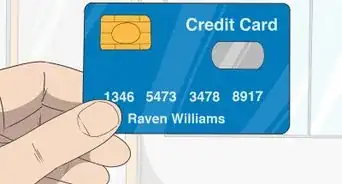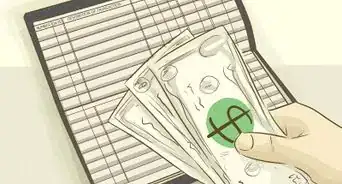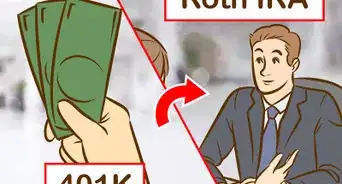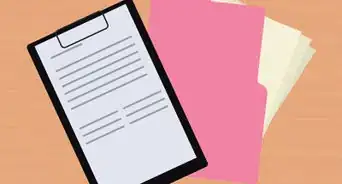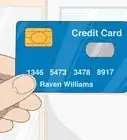This article was co-authored by Brian Colvert, CFP® and by wikiHow staff writer, Janice Tieperman. Brian Colvert is a Certified Financial Planner and the CEO of Bonfire Financial. With over 15 years of experience in finance, he specializes in helping others plan for a secure and confident financial leap into retirement. Brian holds a BA from San Diego State University.
There are 9 references cited in this article, which can be found at the bottom of the page.
This article has been viewed 60,966 times.
Planning for retirement is an ongoing process, so it’s important to keep tabs on both your current and old 401(k) plans. But how do you know where to start if you’ve never accessed your 401(k) before? Not to worry; with the right information and some help from your current employer, you can check your account in a matter of minutes. If you’re searching for an old 401(k) plan, we’ve still got you covered–just scroll down for plenty of tips on how to locate your old plan.
Steps
Viewing Your Current 401(k)
-
1Talk to your workplace’s HR department to get the details on your current 401(k) plan. Clarify which provider manages your 401(k) plan, and ask for the URL to the online portal — since there are many different portal options, it's a good idea to check which one you should access.[1] While you’re at it, check with your HR rep to make sure that your on-file address is up-to-date. This way, you’ll definitely get your quarterly 401(k) statements in the mail.[2]
- If your workplace doesn’t have an HR department, talk to your boss or supervisor instead.
-
2Sign into the online portal associated with your 401(k) plan. Your provider will mail you quarterly statements regarding your 401(k) plan, but the online portal is definitely the easiest, most convenient way to stay up-to-date with your account.[3] Depending on the provider, you might need a registration code from your workplace to get your account and login set up.[4]Advertisement
-
3Inspect your 401(k) plan online at least annually. Your 401(k) is a long-term investment, so you want to periodically make sure that it’s doing well and growing in the direction that you want it to.[5] Just don’t check it on a regular, weekly or monthly basis–your balance will naturally shift over time, and it can be stressful to see your balance at a lower point.[6]
- If you’re having trouble finding your 401(k) balance on the provider’s site, click on the “help” page for navigational tips.
- If you want to check it with more frequency, once every other month is a good idea to make sure that the investments that you have selected are the ones you want and also that the money is going in correctly.[7]
Locating Your Old 401(k)
-
1Get in touch with the HR department of your old employers. Jot down a list of all the people or organizations that you’ve worked for in the past. Then, call up each HR rep and ask them to check their records and see if you ever participated in their 401(k) plan. In some cases, your old employer can help you get access to your old account.[8]
-
2Call the plan administrator’s number from an old statement. There’s a good chance that your old 401(k) provider sent you quarterly statements while you worked for your past employer(s). Sort through your old mail and see if you can find one of these documents. Your 401(k) provider’s contact information should be on that statement, which you can use to relocate your 401(k) plan.[9]
- If you can’t find any old statements, call up one of your former co-workers and see if they have one on hand.
-
3Visit FreeErisa.com if you don’t know your plan provider. According to the Employee Retirement Income Security Act (ERISA), all American employers have to report their employees’ benefit plans (including 401(k)s) via Form 5500.[10] Thanks to this form, your old 401(k) may still have a paper trail. The “FreeERISA” search tool can help follow this paper trail for you, as long as you know the name of your original employer.[11]
- You can visit the website here: https://freeerisa.benefitspro.com.
-
4Check the National Registry with your social security number. The National Registry of Unclaimed Retirement Benefits is full of leftover 401(k) plan balances that were were reported by different employers. Enter your SSN in the database to see if there’s any money attached to your name.[12]
- Check out the National Registry here: https://unclaimedretirementbenefits.com/search
-
5Search the Abandoned Plan database if you think your 401(k) isn’t worth much. If worth less than $5,000, employers are allowed to transfer their employees’ 401(k) accounts to an Individual Retirement Account (IRA) without talking to them first. In some cases, you might be able to find your old 401(k) plan in the Abandoned Plan database, which is managed by the U.S. Department of Labor.[13]
- Check out the Abandoned Plan database here: https://www.askebsa.dol.gov/AbandonedPlanSearch. Make sure you have your plan name, employer name, city, state, and zip code on hand first.
- Keep in mind that if your old employer has an established 401(k) provider, they probably transferred your old 401(k)/new IRA to the same company.
-
6Check missingmoney.com in case your old employer cashed out your 401(k). Unfortunately, your old 401(k) plan might not even exist anymore if your ex-employer got rid of their old retirement plan. Don’t worry, though–you can still reclaim the money, even if it’s deposited somewhere or converted to an IRA.[14] Visit this site to do a quick check for any lost or relocated assets: https://www.missingmoney.com/en/.
- This site isn’t a scam; it’s actually run by the National Association of Unclaimed Property Administrators.
References
- ↑ Brian Colvert, CFP®. Certified Financial Planner. Expert Interview. 27 May 2022.
- ↑ https://www.youtube.com/watch?v=iLM0YAyPg5U&t=0m42s
- ↑ https://www.youtube.com/watch?v=iLM0YAyPg5U&t=0m40s
- ↑ https://www.adp.com/logins/401k-plans.aspx
- ↑ Brian Colvert, CFP®. Certified Financial Planner. Expert Interview. 27 May 2022.
- ↑ https://www.youtube.com/watch?v=iLM0YAyPg5U&t=1m8s
- ↑ Brian Colvert, CFP®. Certified Financial Planner. Expert Interview. 27 May 2022.
- ↑ https://www.nerdwallet.com/article/investing/how-to-find-an-old-401k-and-what-to-do-with-it
- ↑ https://www.nerdwallet.com/article/investing/how-to-find-an-old-401k-and-what-to-do-with-it
- ↑ https://www.dol.gov/agencies/ebsa/employers-and-advisers/plan-administration-and-compliance/reporting-and-filing/form-5500
- ↑ https://freeerisa.benefitspro.com/
- ↑ https://www.nerdwallet.com/article/investing/how-to-find-an-old-401k-and-what-to-do-with-it
- ↑ https://www.forbes.com/sites/davidrae/2018/04/15/find-lost-401k/
- ↑ https://www.nerdwallet.com/article/investing/how-to-find-an-old-401k-and-what-to-do-with-it
- ↑ Brian Colvert, CFP®. Certified Financial Planner. Expert Interview. 27 May 2022.
Expert Q&A
-
QuestionHow do I find my 401k balance?
 Dmitriy FomichenkoDmitriy Fomichenko is the president of Sense Financial Services LLC, a boutique financial firm specializing in self-directed retirement accounts with checkbook control based in Orange County, California. With over 19 years of financial planning and advising experience, Dmitry assists and educates thousands of individuals on how to use self-directed IRA and Solo 401k to invest in alternative assets. He is the author of the book "IRA Makeover" and is a licensed California real estate broker.
Dmitriy FomichenkoDmitriy Fomichenko is the president of Sense Financial Services LLC, a boutique financial firm specializing in self-directed retirement accounts with checkbook control based in Orange County, California. With over 19 years of financial planning and advising experience, Dmitry assists and educates thousands of individuals on how to use self-directed IRA and Solo 401k to invest in alternative assets. He is the author of the book "IRA Makeover" and is a licensed California real estate broker.
Financial Planner It should be online in your brokerage account. Some brokerage accounts will also mail out statements on occasion. If you don't know where that is, just talk to whoever's running the 401k at your place of work.
It should be online in your brokerage account. Some brokerage accounts will also mail out statements on occasion. If you don't know where that is, just talk to whoever's running the 401k at your place of work. -
QuestionCan you lose your 401k money?
 Dmitriy FomichenkoDmitriy Fomichenko is the president of Sense Financial Services LLC, a boutique financial firm specializing in self-directed retirement accounts with checkbook control based in Orange County, California. With over 19 years of financial planning and advising experience, Dmitry assists and educates thousands of individuals on how to use self-directed IRA and Solo 401k to invest in alternative assets. He is the author of the book "IRA Makeover" and is a licensed California real estate broker.
Dmitriy FomichenkoDmitriy Fomichenko is the president of Sense Financial Services LLC, a boutique financial firm specializing in self-directed retirement accounts with checkbook control based in Orange County, California. With over 19 years of financial planning and advising experience, Dmitry assists and educates thousands of individuals on how to use self-directed IRA and Solo 401k to invest in alternative assets. He is the author of the book "IRA Makeover" and is a licensed California real estate broker.
Financial Planner It depends on what's in your account, but every investment carries a certain degree of risk. Whether it's the property value of real estate going down or the stock market crashing, there's never a guarantee that your 401k will only go up. That doesn't mean you shouldn't invest your money, but you do need to realize that there is always going to be some risk.
It depends on what's in your account, but every investment carries a certain degree of risk. Whether it's the property value of real estate going down or the stock market crashing, there's never a guarantee that your 401k will only go up. That doesn't mean you shouldn't invest your money, but you do need to realize that there is always going to be some risk. -
QuestionWhat happens to my 401k if I quit?
 Dmitriy FomichenkoDmitriy Fomichenko is the president of Sense Financial Services LLC, a boutique financial firm specializing in self-directed retirement accounts with checkbook control based in Orange County, California. With over 19 years of financial planning and advising experience, Dmitry assists and educates thousands of individuals on how to use self-directed IRA and Solo 401k to invest in alternative assets. He is the author of the book "IRA Makeover" and is a licensed California real estate broker.
Dmitriy FomichenkoDmitriy Fomichenko is the president of Sense Financial Services LLC, a boutique financial firm specializing in self-directed retirement accounts with checkbook control based in Orange County, California. With over 19 years of financial planning and advising experience, Dmitry assists and educates thousands of individuals on how to use self-directed IRA and Solo 401k to invest in alternative assets. He is the author of the book "IRA Makeover" and is a licensed California real estate broker.
Financial Planner The money is still there, even if you don't work at that job anymore. You can contact your old employer to have that money rolled over into another account once you leave.
The money is still there, even if you don't work at that job anymore. You can contact your old employer to have that money rolled over into another account once you leave.
About This Article
It’s important to check your 401(k) account every year or so to see how your investments are maturing. Read your latest statement on your provider's website to check your current allocation of investments. To find your old 401(k) account, contact your previous employer or search the National Registry of Unclaimed Retirement Benefits online. Don’t worry if there are small fluctuations in your asset classes, since different industries grow at different rates. However, if you want to reduce your future risk, allocate more funds to bonds or monkey market funds. You can also rebalance your allocations by transferring money between investments. It’s best to keep your portfolio diverse in case one market changes drastically. Alternatively, choose automatic rebalancing, which will reallocate your funds if one grows too large or small. For more tips, including how to move your 401(k) account to a new portfolio, read on!
-Step-1-Version-2.webp)

-Step-2-Version-2.webp)
-Step-3-Version-2.webp)
-Step-4-Version-2.webp)
-Step-5-Version-2.webp)
-Step-6-Version-2.webp)
-Step-7-Version-2.webp)
-Step-8-Version-2.webp)
-Step-9-Version-2.webp)


